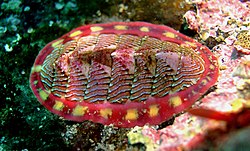| Tonicella | |
|---|---|
 | |
| Tonicella lineata live and in situ, anterior end towards the right | |
| Scientific classification | |
| Domain: | Eukaryota |
| Kingdom: | Animalia |
| Phylum: | Mollusca |
| Class: | Polyplacophora |
| Order: | Chitonida |
| Family: | Tonicellidae |
| Genus: | Tonicella Carpenter, 1873 |
| Type species | |
| Chiton marmoreusFabricius, 1780 | |
| Species | |
See text. | |
Tonicella is a genus of chitons known as the lined chitons. [1]
Contents
The genus name derives from the Greek tonos (something stretched, a brace, a strain) and cell (diminutive). [2]



